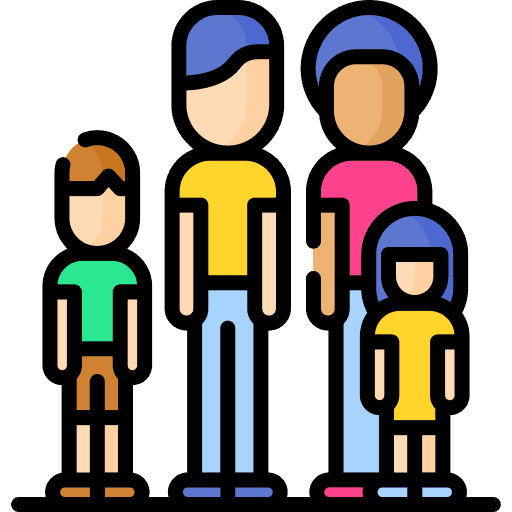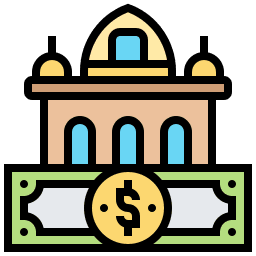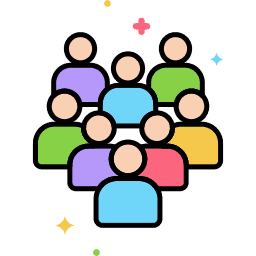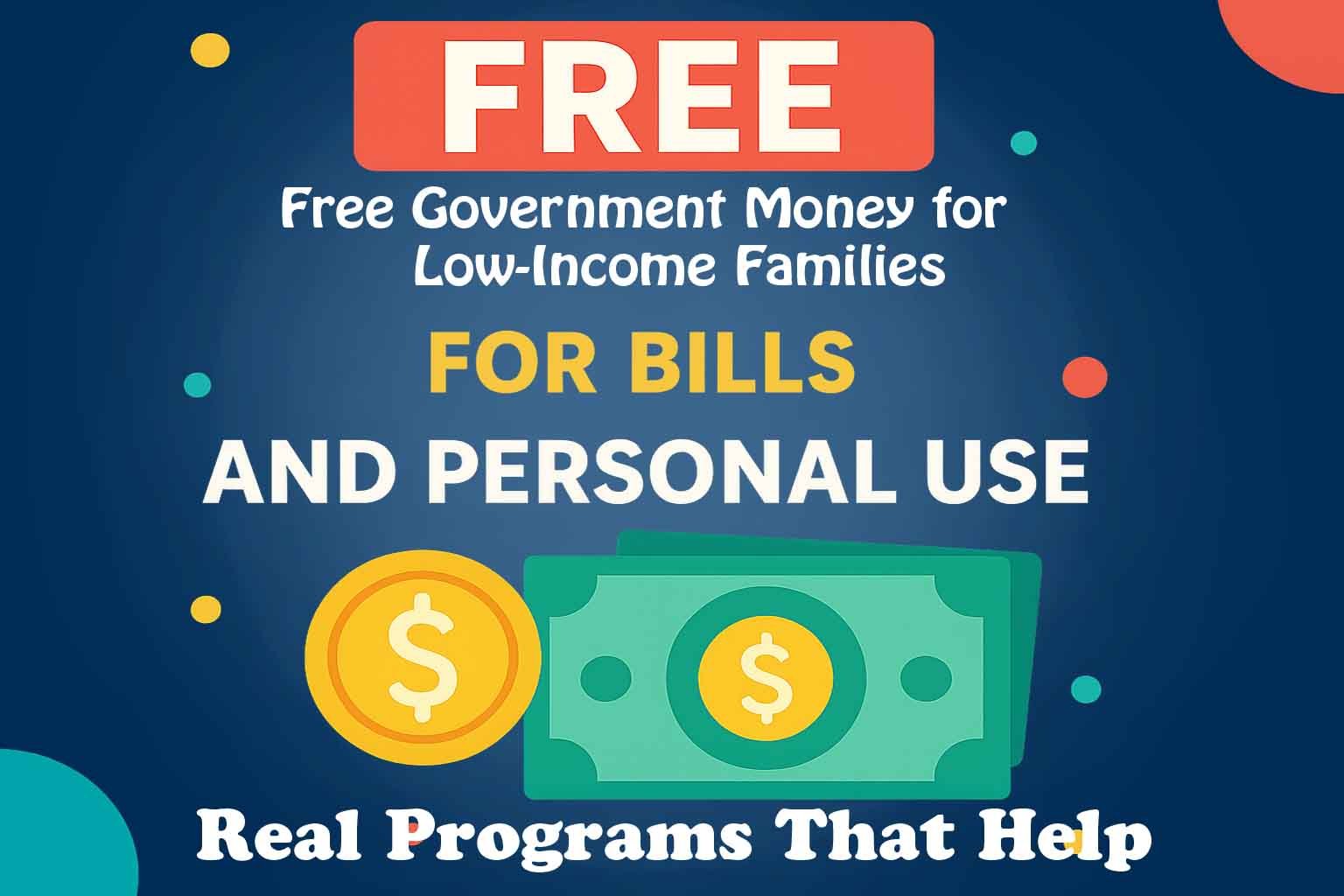Struggling to make ends meet? You’re not alone. In 2025, thousands of low-income families across the United States are seeking ways to access free government money—not loans, but actual assistance that doesn’t need to be repaid.
The good news is that the U.S. government offers a wide variety of federal and state programs to help you cover essential needs like food, housing, healthcare, education, and even utility bills. The challenge? Knowing which ones you qualify for—and how to apply.
This guide will walk you through the best ways to get free government money in 2025 if you’re part of a low-income household. We’ll cover real programs, how they work, and where to apply.
🏡 1. Housing Assistance Programs
Housing is often the biggest monthly expense, and many families live paycheck to paycheck just to stay housed. Luckily, the government provides several housing aid programs:
🔹 Section 8 Housing Choice Voucher Program
This federal program helps low-income individuals and families afford safe housing in the private market. You pay a portion of your income toward rent, and the government covers the rest.
- Where to apply: Local Public Housing Agency (PHA) via HUD.gov
🔹 Public Housing
Low-income families, seniors, and individuals with disabilities can apply to live in government-owned housing developments at reduced rents.
🔹 Emergency Rental Assistance Program (ERA)
ERA is a temporary but active funding program offering free government money for rent and utilities, especially for those affected by economic hardships.
- Where to check: consumerfinance.gov
🥘 2. Food Assistance Programs
Keeping food on the table is a basic need, and the federal government funds programs to ensure families don’t go hungry.
🔹 Supplemental Nutrition Assistance Program (SNAP)
Commonly known as food stamps, SNAP provides monthly funds for grocery purchases via an EBT card.
- Apply here: Benefits.gov – SNAP
🔹 WIC (Women, Infants, and Children)
WIC provides nutrition, baby formula, breastfeeding support, and health referrals for low-income pregnant women, postpartum women, and children under 5.
🔹 National School Lunch Program
Ensures free or reduced-cost lunch (and sometimes breakfast) for children from low-income households attending school.
💡 3. Utility Bill Assistance
Electricity, gas, water, and internet are all essential for everyday life. If you’re falling behind, these programs can help.
🔹 LIHEAP (Low-Income Home Energy Assistance Program)
LIHEAP offers free government money to help pay for heating, cooling, and utility bills.
- Apply via: Benefits.gov – LIHEAP
🔹 Lifeline Program
Offers up to $9.25/month off phone or internet services. This is especially important if you work from home or need to stay in contact with schools or healthcare providers.
- Check eligibility: Lifeline Support
🎓 4. Education Grants for Adults & Children
Education remains one of the most effective ways to break the poverty cycle. Thankfully, multiple grant programs help cover school or college costs.
🔹 Federal Pell Grant
Covers tuition and fees for low-income students attending college or trade school. You do not repay a Pell Grant.
- Apply via FAFSA: studentaid.gov
🔹 Head Start & Early Head Start
Offers early childhood education, meals, and parent support services—completely free for low-income families with children under 5.
🔹 Free School Supplies & Back-to-School Grants
Local non-profits, schools, and state departments often offer back-to-school support for kids.
🏥 5. Healthcare and Medical Assistance
Getting sick shouldn’t mean going broke. These programs make sure low-income families have access to healthcare.
🔹 Medicaid
Provides free or low-cost healthcare coverage to qualifying families. Services include doctor visits, prescriptions, emergency care, and more.
- Apply through your state’s Medicaid office: Medicaid.gov
🔹 Children’s Health Insurance Program (CHIP)
Covers children in families who earn too much for Medicaid but can’t afford private insurance.
💵 6. Cash Assistance and Personal Grants
Sometimes you just need cash for bills, gas, diapers, or other necessities. These programs provide direct or flexible support.
🔹 Temporary Assistance for Needy Families (TANF)
TANF offers monthly cash assistance, childcare support, job training, and more. Amounts vary by state.
- Apply through your local DHS office: Find via Benefits.gov
🔹 State-Specific Cash Grants
States often have their own “general assistance” or “relief programs” for individuals who don’t qualify for federal aid.
👩👧 7. Special Grants for Single Mothers and Families

Single-parent households are particularly vulnerable to poverty. The following programs specifically support single moms and dads:
- Childcare Assistance (CCAP or similar by state)
- Free Car Programs (Working Cars for Working Families)
- Education grants for single mothers (Federal Pell, FSEOG)
- Housing and shelter programs from nonprofits
📌 Where to Start Applying
Finding the right government grant or benefit starts with trusted portals:
- ✅ Benefits.gov – Full directory of federal and state assistance programs
- ✅ USA.gov – The U.S. government’s main help page
- ✅ 211.org – Call or search for local nonprofits and emergency grants
🧭 Tips to Successfully Apply for Free Government Money

- Gather Documents First
Have your ID, proof of income, rent receipts, utility bills, and bank statements ready. - Apply Early
Funds for many programs are limited—early applicants have higher chances of approval. - Don’t Fall for Scams
Government grants are always free to apply for—never pay an upfront fee. - Follow Up
Contact your caseworker or agency if you haven’t received a decision in 2–3 weeks.
Free Government Money for Students
Pursuing education in the U.S. can be expensive—but the federal government offers free government money for students through a variety of grants, scholarships, and assistance programs. Unlike loans, this money does not need to be repaid, making it a powerful tool for students from low- to moderate-income households.
One of the most well-known sources of free money is the Federal Pell Grant, awarded to undergraduate students based on financial need. For the 2025–2026 academic year, eligible students can receive up to $7,395 through Pell Grants. To apply, students must complete the Free Application for Federal Student Aid (FAFSA), which also determines eligibility for other grants like the Federal Supplemental Educational Opportunity Grant (FSEOG) and state-based education aid.
Additionally, many states and colleges offer their own grants. For example, the Cal Grant in California or the TAP program in New York. Specialized grants for single parents, minorities, and students with disabilities are also available.
You can learn more and start your FAFSA application here: https://studentaid.gov
Or explore all education-related benefits through Benefits.gov – Education Grants
These programs make higher education more accessible and affordable, allowing students to focus on learning rather than loans.
Free Government Money For Seniors Over 60

Seniors over the age of 60 in the United States may be eligible for various forms of free government money, provided through federal and state assistance programs aimed at supporting their health, housing, nutrition, and overall well-being. These benefits are not loans and do not need to be repaid, making them a lifeline for many older Americans living on fixed incomes.
One of the key programs is Supplemental Security Income (SSI), which provides monthly cash payments to seniors with limited income and resources. Another major resource is Social Security Retirement Benefits, which begin as early as age 62 and are based on your work history.
For housing, the Section 202 Supportive Housing for the Elderly Program offers affordable housing with supportive services. Seniors can also get help with energy bills through the Low-Income Home Energy Assistance Program (LIHEAP).
When it comes to nutrition, seniors can receive free groceries or meals through the Senior Farmers’ Market Nutrition Program (SFMNP) and Meals on Wheels.
Healthcare needs are covered by Medicare, but for those with limited means, Medicare Savings Programs (MSPs) and Medicaid can help cover premiums, co-pays, and prescriptions.
✅ Learn more about senior benefits at https://www.benefits.gov/categories/Seniors
These programs are designed to ensure that aging doesn’t come with unnecessary financial burdens—help is available, and it’s 100% free for those who qualify.
Free Government Money For Unemployed
If you’ve recently lost your job or are struggling to find work, you may qualify for free government money for unemployed individuals through several assistance programs. These benefits are designed to help cover essential living expenses while you search for new employment opportunities—and they don’t need to be repaid.
The most well-known option is Unemployment Insurance (UI), which provides temporary cash assistance to those who have lost their jobs through no fault of their own. Each state manages its own program, so benefit amounts and eligibility rules vary. You can apply through your state’s labor department or visit https://www.careeronestop.org to get started.
In addition to UI, the Supplemental Nutrition Assistance Program (SNAP) offers monthly food benefits to unemployed individuals and families. You may also qualify for Temporary Assistance for Needy Families (TANF), which provides both cash aid and employment support services.
The Low-Income Home Energy Assistance Program (LIHEAP) can help pay your utility bills, and Medicaid provides healthcare coverage at no cost or very low cost.
For job retraining and skill-building, the government funds programs like WIOA (Workforce Innovation and Opportunity Act), which you can explore here: https://www.dol.gov
Don’t wait—these programs exist to support you during hard times, and applying is often simpler than you think.
Free Government Money for Individuals

Many Americans don’t realize that there are legitimate ways to access free government money for individuals—and no, this isn’t a scam or a loan. The federal and state governments offer a wide variety of grant and assistance programs that provide cash support, housing aid, food benefits, healthcare coverage, and more to qualified individuals based on income, personal situation, or specific needs.
One of the most accessible programs is the Supplemental Nutrition Assistance Program (SNAP), which offers monthly funds to help with groceries. Medicaid provides free or low-cost healthcare, while LIHEAP helps individuals pay energy bills during extreme seasons. If you’re out of work or underemployed, Unemployment Insurance and TANF (Temporary Assistance for Needy Families) can provide much-needed cash aid.
Students and single parents may qualify for Federal Pell Grants or childcare assistance. Seniors can receive benefits through SSI (Supplemental Security Income) and Medicare Savings Programs.
While these funds are not handed out freely to everyone, they are 100% free for eligible recipients. Start by checking your eligibility at Benefits.gov, where you can explore over 1,000 federal and state benefit programs.
Don’t miss out—free government money is real, and it can ease financial burdens significantly for those who qualify.
Free Grant Money for Bills and Personal Use
When financial hardship strikes, many people wonder if there’s any free grant money for bills and personal use—and the answer is yes, there is. While the government doesn’t just mail out checks to anyone who asks, several federal and state programs do offer non-repayable financial aid to individuals and families who qualify based on income, age, disability, or other personal circumstances.
One major source is the Low-Income Home Energy Assistance Program (LIHEAP), which helps with heating and utility bills. You can also apply for Temporary Assistance for Needy Families (TANF), which offers monthly cash payments that can be used for rent, transportation, childcare, and other personal expenses. Seniors and people with disabilities may qualify for Supplemental Security Income (SSI), which provides monthly income support.
Additionally, some nonprofit organizations offer emergency grants to help cover medical bills, rent, groceries, and personal care needs. Programs like Modest Needs or Catholic Charities USA are excellent resources for such aid.
To find out what you may qualify for, visit Benefits.gov or your state’s human services department website. These grants aren’t loans—they’re real help that doesn’t need to be repaid, offering peace of mind during tough financial times.
🙋♀️ Frequently Asked Questions (FAQs)
1. Can I really get free government money as a low-income parent?
Yes. Programs like SNAP, TANF, Section 8, and Pell Grants offer non-repayable aid to those who qualify.
2. Do I have to repay government grants?
No. Grants are not loans. As long as you use the funds for their intended purpose, repayment is not required.
3. Can undocumented immigrants receive these grants?
Eligibility varies. Some programs like WIC may offer limited support, but most federal programs require legal status.
4. How do I know if I qualify for these programs?
Each program has specific income and family size guidelines. Use Benefits.gov to check your eligibility.
5. What’s the fastest government program to get cash?
TANF or state general assistance programs often provide the quickest cash support after approval.
6. Are there grants for buying a house or car?
There are housing vouchers and nonprofit car donation programs, but no direct cash grants for purchases.
7. Can I apply for multiple programs at once?
Absolutely! Most low-income families qualify for more than one type of aid—apply to all you’re eligible for.
8. Do these programs vary by state?
Yes, especially housing and cash aid. Always check your state-specific rules.
9. Can single fathers also qualify for these grants?
Yes. While many programs highlight single mothers, all single parents can qualify if they meet the income and need criteria.
10. Where can I get help filling out applications?
Call 211, contact a local nonprofit, or visit a community action agency. They often help with applications for free.
✅ Final Thoughts
Navigating financial hardship is tough—but you don’t have to do it alone. These free government money programs for low-income families in 2025 can provide real relief and open the door to stability, education, and opportunity. Whether you need help with rent, food, school, or bills, there’s a grant or assistance program ready to support you.
Start by checking your eligibility on Benefits.gov and applying through your state agencies. Take one step at a time—and don’t give up. Help is out there.
For More Information you can check our Home Page.
Recent Posts
- Education Grants for Adults Returning to School in 2025: Your Complete Guide
- Healthcare Grants for Seniors Over 60 in 2025: Your Complete Guide to Free Support
- Free Government Money for Low-Income Families 2025: Real Programs That Help
- Eligibility Criteria for Federal Education Grants for Single Mothers
- How to Apply for Federal Housing Assistance Grants in 2025
